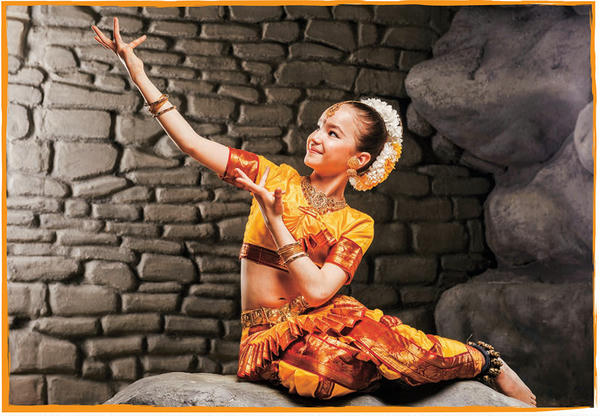66 Why Should We Learn a Cultural Art?§
A young girl in silk costume gestures toward the Divine during a Bharatanatyam dance. Her years of hard work and self discipline have brought a grace and refinement that will last a lifetime.§
SHUTTERSTOCK§
It is a great joy to listen to a fine singer or musician, or watch a gifted dancer perform. It is uplifting to see beautiful paintings by a devoted Saiva artist. It is enchanting to hear someone tell a story well. Each song, each art piece or performance is a gift to every devotee who experiences it. Gurudeva encouraged devotees to perfect a form of Saiva art, singing, drama, dance or a musical instrument. The ideal time to start is in childhood. He also praised the merits of learning a creative skill requiring the use of one’s hands, such as pottery, sewing, weaving, painting, gardening, baking and the building arts. All these talents manifest creative benefits for family and community. There are so many options for each of us. You could learn a form of classical Indian dance. You could learn music, such as voice, vina, flute or drum. You may learn Sanskrit chanting or dramatic storytelling. You could become an expert at weaving flower garlands, writing poems, sculpting or carpentry. You can create kolam floor designs and other handmade decorations. You can perfect the art of cooking and prepare delicious prasadam dishes for festivals. Learning an art or skill takes hard work, willpower and dedication. These are strengths you can apply to everything you do. Each skill or art gives you new ways of uplifting your friends, family and community. These cultural and creative expressions are fulfilling to you as well. You become an accomplished human being. And if you learn something well, you can teach that skill to others. There are 64 cultural arts, or kalas, in Hindu tradition. In Saiva Dharma Shastras Gurudeva offered two contemporary lists, one for girls and one for boys.§
GURUDEVA: The Hindu enjoys all the facets of life as transmuted into a religious expression in art. The Hindu’s art is a religious art—drawing, painting and sculpture of the Gods, the devas, and the saints of our religion. The music is devotional and depicts the tones of the higher chakras, echoes the voices of the Gods; and the dance emulates the movements of the Gods.§

